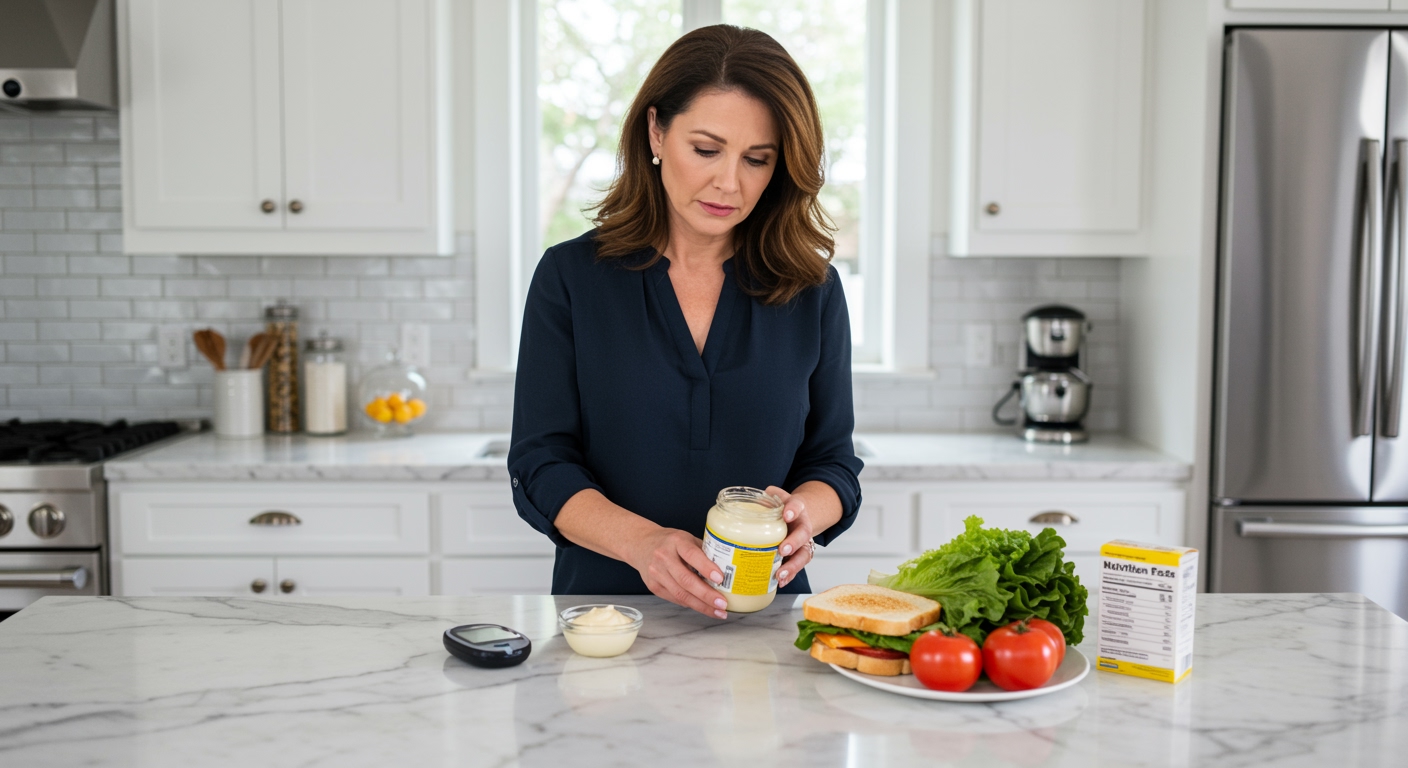✪ Key Takeaway: Mayonnaise is generally safe for diabetes as it contains no carbs and has a zero glycemic index.
Introduction
You reach for that jar of mayonnaise to make your sandwich, then pause.
If you have diabetes, you might wonder whether this creamy condiment will send your blood sugar soaring or if it fits safely into your meal plan.
Hi, I’m Abdur, your nutrition coach, and today I’m going to explain exactly how mayonnaise affects your blood sugar and whether you can enjoy it without worry.
Does Mayonnaise Raise Blood Sugar?
The simple answer is no – mayonnaise does not raise blood sugar levels.
Traditional mayonnaise contains only three main ingredients: egg yolks, oil, and vinegar or lemon juice.
None of these ingredients contain carbohydrates, which are the nutrients that directly impact your blood glucose.
The glycemic index of mayonnaise is zero, meaning it causes no blood sugar response when consumed alone.
This makes mayonnaise one of the safest condiments for people managing diabetes.
However, you need to read labels carefully because some commercial varieties add sugar or corn syrup, which can change this equation completely.
✪ Fact: Regular mayonnaise contains zero grams of carbohydrates per tablespoon serving.
What About the Fat Content?
Mayonnaise is almost entirely fat, with about 10-11 grams per tablespoon.
While this might sound alarming, fat actually helps slow down digestion and can prevent blood sugar spikes from other foods in your meal.
When you eat mayonnaise with bread or vegetables, the fat content helps create a more gradual release of glucose into your bloodstream.
This is particularly beneficial for people with diabetes who need to avoid rapid blood sugar fluctuations.
The type of fat matters too – most commercial mayonnaises use vegetable oils that are neutral for blood sugar control.
However, the high calorie content means you should still watch your portion sizes to maintain a healthy weight, which is crucial for diabetes management.
✪ Pro Tip: Use mayonnaise to help slow the absorption of carbs from bread and vegetables in your meals.
Are There Hidden Sugars to Watch For?
Not all mayonnaises are created equal when it comes to diabetes safety.
Some brands add sweeteners like high fructose corn syrup, sugar, or honey to enhance flavor and extend shelf life.
These added sugars can contain 1-3 grams of carbohydrates per serving, which might seem small but can add up quickly if you use multiple servings.
Light or reduced-fat mayonnaises are often the biggest culprits for hidden sugars.
Manufacturers remove fat but replace it with starches, sugars, or other thickeners to maintain texture and taste.
Always check the ingredient list and nutrition facts panel before purchasing any mayonnaise product.
Look for versions that list only eggs, oil, vinegar, and perhaps salt as ingredients for the safest option.
✪ Note: Light mayonnaise often contains more carbs than regular full-fat versions due to added thickeners.
How Much Mayonnaise Can You Safely Eat?
While mayonnaise won’t spike your blood sugar, portion control remains important for overall health.
A standard serving size is one tablespoon, which contains about 90-100 calories.
For most people with diabetes, 1-2 tablespoons per day fits comfortably within a healthy meal plan.
The main concern isn’t blood sugar but rather the high calorie density that can contribute to weight gain if consumed excessively.
Excess weight makes diabetes harder to manage and can worsen insulin resistance over time.
Consider using mayonnaise as a flavor enhancer rather than the main component of your meal.
Mix it with herbs, spices, or vinegar to create flavorful dressings that let you use less while still enjoying great taste.
✪ Pro Tip: Mix mayonnaise with Greek yogurt to reduce calories while maintaining creamy texture and protein content.
What Are the Best Alternatives?
If you want to reduce calories or try different flavors, several diabetes-friendly alternatives work well.
Avocado provides healthy fats and fiber while creating a similar creamy texture for sandwiches and salads.
Greek yogurt mixed with herbs offers protein and probiotics with fewer calories than traditional mayonnaise.
Olive oil-based mayonnaises provide better fat quality with the same blood sugar benefits.
Homemade mayonnaise lets you control exactly what goes into your condiment and avoid any unwanted additives.
Mustard, while different in flavor, contains virtually no calories or carbs and adds tangy flavor to meals.
The key is finding alternatives that you actually enjoy eating, so you stick with healthier choices long-term.
✪ Fact: Homemade mayonnaise stays fresh for up to one week when stored properly in the refrigerator.
The Bottom Line
Mayonnaise is generally safe for people with diabetes because it contains no carbohydrates and won’t raise blood sugar levels.
Smart food choices come from reading labels, not avoiding entire food groups, and mayonnaise proves this point perfectly when you choose the right version and watch your portions.
I’d love to hear about your experience with mayonnaise and diabetes management – share your questions, favorite brands, or creative ways you use this condiment in the comments below.
References
At NutritionCrown, we use quality and credible sources to ensure our content is accurate and trustworthy. Below are the sources referenced in creating this article:
- PMC: Dietary Patterns and Diabetes Management
- Glycemic Index Net: Mayonnaise Glycemic Index
- Diabetes Care Journal: Standards of Medical Care in Diabetes
- Klinio: Mayonnaise and Diabetes





